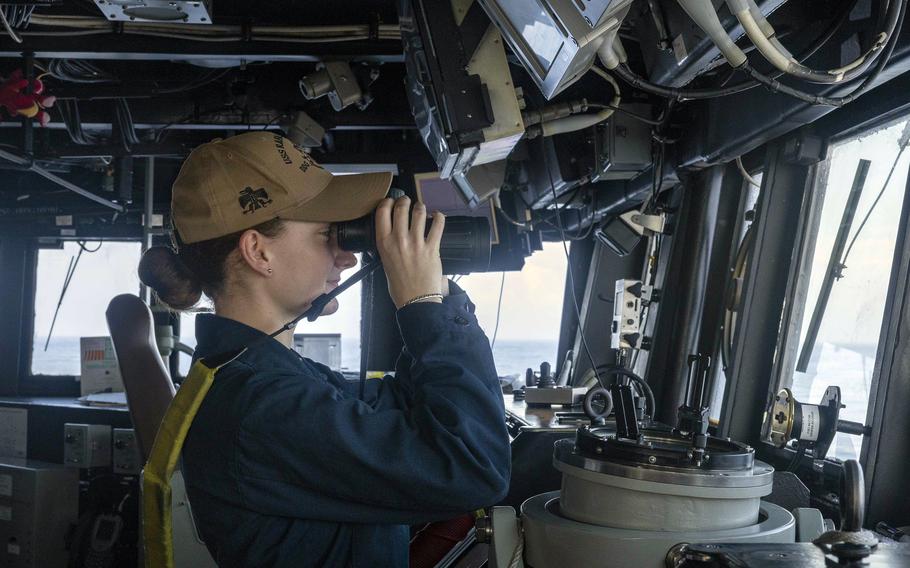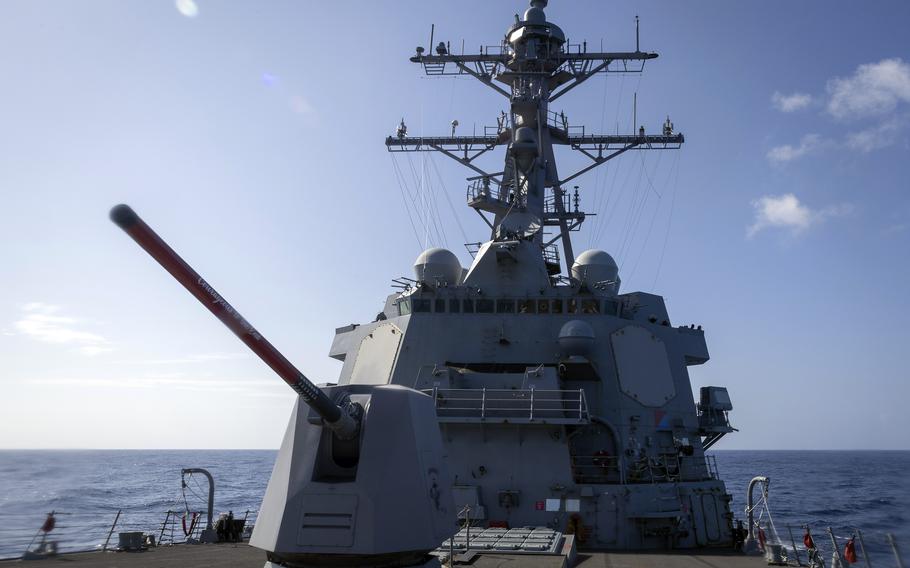
Ensign Julia Olson stands watch from the bridge of the guided-missile destroyer USS Rafael Peralta near the Luzon Strait, March 1, 2024. (Devin Monroe/U.S. Navy)
TOKYO — Dockworkers went on strike in protest Monday when a U.S. Navy guided-missile destroyer visited a civilian port on the southern Japanese island of Ishigaki, according to local news reports.
The USS Rafael Peralta, based south of Tokyo at Yokosuka Naval Base, stopped for rest and replenishment allowed under the Japan-U.S. status of forces agreement, Japanese national broadcaster NHK reported that evening. SOFA outlines the rights and responsibilities of U.S. military forces in Japan.
Local officials had granted permission for the visit, but dockworkers began a strike at the port Monday afternoon, citing concerns about the impact on logistics, the broadcaster reported.
The Rafeal Peralta is scheduled to depart 9 a.m. Wednesday, the Ryukyu Shimpo newspaper reported Tuesday. The strike will continue until it departs, according to the Okinawa Times.
Ishigaki, part of Okinawa prefecture, is 160 miles east of Taiwan. It is a popular tourist destination and the site of Camp Ishigaki, a Japan Ground Self-Defense Force base armed with anti-ship and surface-to-air missiles that opened in March 2023.
The island is one of three where Japan plans to install an upgraded version of its Type-12 surface-to-ship missile by 2026 to counter perceived threats from China and North Korea.
The Ishigaki port call was part of routine operations and training in the region, a spokesman for Destroyer Squadron 15, Navy Lt. j.g. Ronan Williams, said by email Tuesday.

The guided-missile destroyer USS Rafael Peralta sails near the Luzon Strait in the Philippine Sea, March 1, 2024. (Devin Monroe/U.S. Navy)
Local officials refused a Navy request to use a cruise ship berth at the port because the draft is too shallow, but approved a request to anchor offshore, Ishigaki Mayor Yoshitaka Nakayama posted on X Monday.
“I believe it is a regular use since the purpose is rest and replenishment,” he told reporters Monday, according to NHK. “Ishigaki port is open internationally and it can be used as long as it is applied based on the status of forces agreement, so I see no issues.”
Okinawa prefecture on Friday had asked the Navy to cancel the visit, a spokeswoman for the prefecture’s military base affairs division said by phone Tuesday. Some Japanese government officials may speak to the press only on condition of anonymity.
“It’s Okinawa prefecture’s consistent policy for U.S. military to refrain from the use of civilian ports except in case of emergency,” she said. “It is extremely regrettable that the ship came even though the prefecture asked them not to.”
Okinawa Gov. Denny Tamaki made similar remarks to reporters Monday. The Navy “should refrain from its vessels using civilian ports, so there is no need to conduct strikes,” he said.
Okinawa officials made similar complaints in September when the USS Pioneer, a mine countermeasures ship based at Sasebo Naval Base, Japan, stopped overnight on Ishigaki, marking the Navy’s first visit to the island in over a decade.
The U.S. military benefits from access to as many ports as possible, according to Grant Newsham, a retired Marine colonel and senior researcher with the Japan Forum for Strategic Studies in Tokyo.
“And it’s important to use them in so-called ‘phase zero’ — peacetime, or at least before the shooting starts,” he said in an email Tuesday.
Port calls make military personnel familiar with a location and operating environment, so they don’t need to figure things out on the fly in an emergency, he added.
More ports and airfields make U.S. forces a harder target and gives them better odds of surviving an attack on their main base, Newsham said.
“By treaty, the Japanese government is obligated to provide such access to facilitate the operations of U.S. forces in Japan — and the U.S. forces are in fact operating to defend Japan,” he said. “It’s important that the Americans get over their self-imposed restraint on doing what’s necessary to both protect Japan and also increase their own odds of survival. These need to be regular visits.”